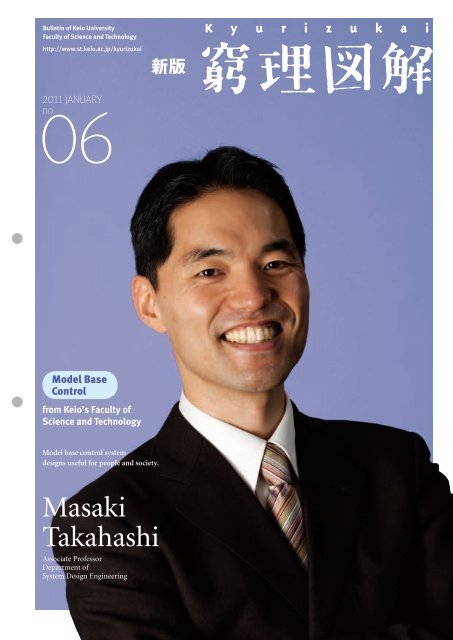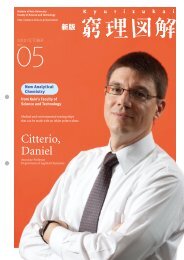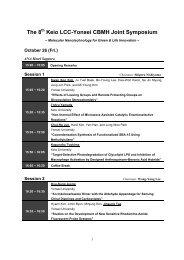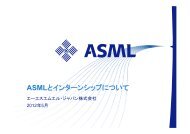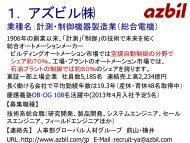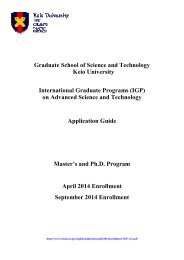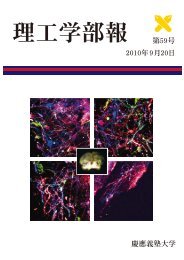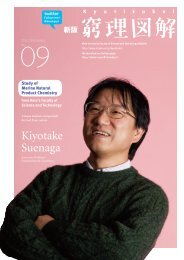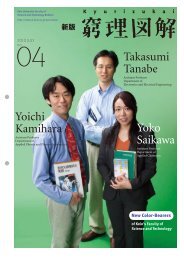Masaki Takahashi - Keio University
Masaki Takahashi - Keio University
Masaki Takahashi - Keio University
You also want an ePaper? Increase the reach of your titles
YUMPU automatically turns print PDFs into web optimized ePapers that Google loves.
IntroducingResearchersAssociate Professor <strong>Masaki</strong> <strong>Takahashi</strong> tackles the effective use ofmodel base control technology to develop systems design that benefits peopleand society at large.Making the Most ofHigh-Precision Control Technologyto Design Systems Useful for People and SocietyModel base control technology meets the needs of people and societyAutomobiles as a convenient means to transport people and cargo, highrisecondominiums providing ample residential space in the center ofmetropolitan areas . . . the development of technology has benefited people’slifestyles and prosperity of society in modern times. But when we look at suchamenities brought by technological advances from a human viewpoint, thereare still people who suffer from carsickness and high-rise buildings that shakedue to earthquakes or strong winds, causing us discomfort. A new attempt isnow being made to take a new look at the relationship between technologyand humans from the perspective of “Safety and Comfort for Humans.” In thisissue, we listened to Associate Professor <strong>Masaki</strong> <strong>Takahashi</strong> who is contributingto the development of model base control systems to create products andsystems useful for people and society.on our own judgment. But modelingincluding that of users is inevitable tocreate systems that can be practicallyused in actual society,” remarks AssociateProfessor <strong>Takahashi</strong>.As research themes, Dr. <strong>Takahashi</strong>has chosen robotics, automobiles andbuildings – realms that have much to dowith people and society. This is becauseby making use of model base control heaims to contribute to the development ofproducts and systems useful for peopleand society.Realizing a better relationshipbetween people,society and machines“Model Base Control” is a method torealize effective control by modeling atarget system and developing an optimalcontrol technology for the target. Anadvantage of this method is that itallows you to develop a desired controltechnology while conducting simulations.On the other hand, there are cases wherethe system developed cannot work assimulated if the model precision is pooror the simulated operating environmentdiffers significantly from reality. Thismakes it important to develop highlyaccurate modeling as well as to design acontrol system that can properly respondto changes in the environment andmodeling errors.“Modeling including that of theoperating environment is indispensableto perform highly precise model basecontrol. Of various factors involved,the most difficult is to assume users.Modeling of users is difficult becausewe humans conduct ourselves basedControlling robots’autonomic movementAn application of model base controlcan be found in robots for automatedguidance and transport of expendablesand other articles in hospitals.Dr. <strong>Takahashi</strong> adds, “We aim tomake such guidance/transport robotsautonomic to act and move aroundinside a hospital. Therefore, we aredeveloping a control technology witha focus on how robots should conductthemselves in human society. The keypoint here is how humans will react whenthey encounter a robot. Some may besurprised and leave the place, while otherwill be interested and come closer. Weare currently making improvements tothe robot so that it can predict and judgethe behavior the person in front of it willtake and respond to the person properly,taking the past behavioral history and thecurrent situation into account. I feel thatpeople’s recognition of robots today is stillat a low level, which is a major barrier tofull introduction of robots to society. ForSafe and more comfortablesociety with control technologyControl technology finds its applications invirtually every aspect of our modern society– from daily lives to industry and to spacedevelopment. If this technology advancesf u r t h e r, i t w i l l b e c o m e p o s s i b l e t o u s eautomobiles and guidance/transport robots, etc.more safely and comfortably as shown in thisillustration.2
obots to be widely accepted by society,therefore, it is important to providepeople with more opportunities allowingthem to see and better understandrobots.”The key to achieving this goal lies inon-site experiments and observations. Inother words, we need to visit hospitalsand observe, as a robot’s eyes would do,nurses carrying medical supplies andthe like and how patients and visitorswill look at them, as well as how patientson wheelchairs or crutches will act andmove.He continues, “We conduct experimentsand observations together with many,such as representatives from robotmanufacturers and students. Then allof us have a meeting to discuss theexperiment and observation results. Weextract characteristic elements from thebehavior of nurses and people aroundthem, which form the foundation for thedevelopment of component technologiesneeded. In fact, on-site studies are a richsource of discovery. For example, deskresearchers tend to create advancedhigh-performance robots by introducingthe latest in technology. However, thetechnology actually needed to transportgoods in hospitals is not the technologyneeded to create fast-moving robots.On the other hand, if the robot designplaces too much emphasis on safety, therobot may cease moving, incapable ofresponding to constant changes occurringin the environment. This means that weneed to develop technologies such asthose enabling the robot to recognizeobstacles peculiar to a place in questionand evade them at a speed suitable for theplace.”Protecting buildingsfrom earthquakes and wind,while enhancing comfortThere are types of model base controlthat contribute to society in relation tosocial infrastructure. A typical exampleis the control technology for quakeabsorbingbase-isolated structures.Heretofore, architects assumed themagnitude of earthquakes beforehandand built structures that could withstandthe assumed magnitude. Dr. <strong>Takahashi</strong>’sapproach is different. He is thinking of anactive quake-absorbing control based onpositive utilization of the latest seismicground motion forecast/warning system.“I’m now proposing a quake-absorbingcontrol system based on the utilization ofinformation from emergency earthquakereports. If the hypocenter location ofan earthquake and its magnitude canbe predicted in advance, the controlsystem can enhance the quake-absorbingperformance of buildings accordingly.Control technologies active on various technological forefrontsControl technology can control quake-absorption of high-rise buildings, dealing with individualearthquakes based on information from emergency earthquake reports. The control technology forsatellites and other spacecrafts can also be applied to terrestrial issues like shaking control of elevatorropes.Just as a strongly rocking swing can becontrolled simply by changing the timingof its rocking, we can effectively controlquaking and realize highly safe quakeabsorptionby controlling the quakeabsorbingdevice in a way to alleviatethe structure’s shaking caused by seismicground motion propagated from thehypocenter.”Dr. <strong>Takahashi</strong>’s approach is based ona combination of knowledge obtainedfrom preceding studies on the way theground quakes (propagation routes ofseismic ground motion and groundstructures taken into consideration) andinformation available from emergencyearthquake reports. This approach isattracting attention as a new method ofquake-absorbing control as expansionand improvement of social infrastructurerapidly advance today.Dr. <strong>Takahashi</strong> reveals his view saying,“This active shake control applies notonly to earthquakes but also to shaking ofbuildings due to strong winds. I predictan ever-increasing need to control theshaking of buildings, which is interlockedwith new forecast/warning systems.”Use of satellite-controlling knowhow to control elevator ropesControl technologies are also beingdevelop ed to control a variety ofequipment operating in the spaceenvironment. One example is theattitude control technology for smallsizesatellites. In recent times, compactsatellites are equipped with large-size,flexible and lightweight solar panels tomeet their increasing power demand. Ifthe satellite main body, heavily loadedwith cameras and other equipment,c h a n g e s i t s d i r e c t i o n t o w a r d a nobservation target, that motion shakesthe flexible solar panel, causing photoimage distortion just as we experiencewith our digital camera shake.Dr. <strong>Takahashi</strong> says, “Depending onorbit, it can take several days for asatellite to return to the position forphotographing the same observationtarget point on the Earth. Meanwhile,there are increasing demands forphotographing multiple observationpoints at one time – such as placessuffering from serious environmentaldisruption and places of large-scalenatural disasters. In such cases, thesatellite needs to change its attitudepromptly. Such attitude change involvesthe shaking of flexible structures likethe solar panel. But it becomes possibleto change the satellite attitude promptlywithout shaking if we apply a controltechnology.”The phenomenon, in which the wholeof a flexible structure shakes, is notlimited to artificial satellites. Similarphenomenon can be seen in elevatorropes, for example.“Elevator ropes are becoming longerand longer as buildings rise higher andhigher, causing the problem of shakingelevator ropes. The control technologyenabling rapid change in attitude ofsatellites without shaking can be appliedto elevator ropes on the ground surface –this is a merit of the model base controltechnology based on mathematics anddynamics.”Endorsed by a rich track record, “ModelBase Control” technology is sure toenhance our quality of life and contributeto the betterment of society. (Reporter & text writer: Kaoru Watanabe)3
InterviewListening to what Associate Professor <strong>Masaki</strong> <strong>Takahashi</strong> saysI’d like to interact withsociety through dynamicsand control technology.Using the model base control technology and by digging up latent needs ofpeople, Mr. <strong>Masaki</strong> <strong>Takahashi</strong> pursues the creation of products and systemstruly needed by people and society. In his students’ ages, sports were the focusof his enthusiasm. He confesses that, though he was good at mathematicsand physics, he was skeptical about why he was learning these subjects. But alecture he received at the university class awakened his interest in dynamicsand control technology, which brought him into a life of scientific researchday and night. But his style of research pursuit has been inseparable frominteraction with people and society. In fact, his sphere of activity extends farbeyond his laboratory, with his eyes always directed toward the outside society.What kind of life did you live as astudent?Recalling those student days, I wastotally absorbed in soccer and skiing. Itook up soccer as an elementary schoolboy. I was enthusiastic about this sportbecause eleven members playing theirrespective roles in a team play was greatfun. As such a soccer-focused schoolboy, it was beyond imagination that Iwould choose a career as a researcher inthe future. While I’m now specializing incontrol engineering and dynamics, forme as a high school student physics wasmerely a subject “a bit more favorite thanliberal arts-oriented subjects.”Then, about when did you becomeinterested in control engineering anddynamics?I took an interest in these studiesonly after I was admitted to university.During my high school days, I couldn’timagine that scientific formulas writtenin textbooks could be actually useful forsociety, nor could I recognize that theyare necessary to understand and explainvarious phenomena in our lives. I shouldhave noticed it much earlier.Yo u j o i n e d t h e S y s t e m D e s i g nEngineering Department of <strong>Keio</strong><strong>University</strong>’s Faculty of Science andEngineering, right?Yes. To tell you the truth, I was oneof the first students who were admittedto the then newly established SystemDesign Engineering Department. Therewas a description on the department’sbrochure: “To create systems geared tothe forthcoming society, knowledge fromboth mechanical and electrical studies isrequired. As such, the department aimsto foster talents capable of designing,analyzing and evaluating systems.”Without any mental resistance, I couldagree to the concept of designing anoverall system by combining knowledgefrom different fields of study.When I was a freshman, this newlyborn department was not equipped witheverything. But we students enjoyed theprivilege of being taught by marvelousteachers who lectured us with greatenthusiasm and ingenuity, which morethan made up for shortage of equipment.In particular, lectures on dynamics andcontrol engineering were so impressivethat they revolutionized my awareness.My supervisor, Professor Kazuo Yoshida,was responsible for these lectures. Hewas kind enough to explain, in an easy-4
to-understand way, that mathematicsand physics, which I had studied at highschool, and the laws of dynamics I wasthen going to learn at <strong>Keio</strong> could beused as useful tools for society and wereactually being applied to various businessand industrial forefronts.Mathematics and physics – the fieldswhere I was merely interested in solvingproblems – actually have much to dowith our daily lives . . . it was a surprisingaspect of physics. This experiencemotivated me to know more aboutphysics.Professor Yoshida’s remarks brought adrastic turnaround in your impressionsabout physics, right?During his first classroom lecture, Prof.Yoshida showed us a video footage of theTacoma Narrows Bridge in the State ofWashington, U.S.A. This bridge collapsedsoon after completion due to wind, strongbut within the presumed velocity limit.This vivid visual record of the accidentmade the bridge famous. Many of youmay still remember it. It was the verymoment I became strongly aware of therole dynamics and control technologyplay.The impressions I received at that timewere so strong that, when the time camefor me as a junior to decide which lab tochoose from, I visited Prof. Yoshida’s laband, after observing what was going on,decided to study under Prof. Yoshida.When giving lectures, he was usually softspoken and did his best to explain thingsin an easy-to-understand way. But whenit comes to research activities, he wasvery serious, giving sharp and pinpointcriticism and advice as necessary. Nowfinding myself in a position to guidestudents, I would like to follow Prof.Yoshida’s example. But it’s difficult and I’mstriving from day to day.To my great regret, Prof. Yoshida passedaway in 2008; I can no longer listen to hisvaluable views. What I can do now is todo my best to approach Prof. Yoshida’slevel by following his advice.What else do you bear in mind as auniversity teacher?I’m trying to arrange so that activitiesof my students will not be confinedto the lab but interact more and morewith the outside world. In my opinion,exchanges with other universities andinteraction with foreign people willprove valuable not only for their researchactivity here, but also for their liveseven after graduation. For example, mystudents’ off-campus activities includeparticipation in a space-related eventheld in Noshiro City in Akita Prefecture,and an event (ARLISS) in the Black RockChallenging the creationof comfortable lifestyleswith controlengineering and dynamics<strong>Masaki</strong> <strong>Takahashi</strong>With control engineering and intelligentcontrol engineering as his specialties, Mr.<strong>Takahashi</strong> uses model base control technologyto address research themes relating tomechanical control, intelligent robotics andspace engineering, among others. He obtaineda doctor’ s degree at <strong>Keio</strong> <strong>University</strong> GraduateSchool of Science and Technology in 2004.He became a postdoctoral research fellow at<strong>Keio</strong> <strong>University</strong> in 2004, a researchassociate at <strong>Keio</strong>’ s Facultyof Science and Technology in2005, an assistant professorin 2007, and the currentposition as an associateprofessor in 2009.Desert, Nevada, U.S.A. that features theuse of a rocket to launch a simulatedsatellite and recovering it. Anotherexample is a student-initiated experimentclass for flying PET bottle rockets as partof our Campus Festival.The experiment class targetingelementary school children allows themto learn and experience the mechanismby which rockets can fly, as well as thephenomenon in which the distance offlight varies according to changing theangle of the rocket’s trajectory. I believeexperiencing things themselves willremain as lasting impressions. Whenthese children grow up and learn physicsat high school, they may be able todevelop their interest in this study ifthey can relate the theory to their pastexperience, saying “Now I understandwhy my rocket could fly at that time!” Iwould also like my lab students to realizethe difficulty of teaching things to others.Do you have any person who remainsparticularly outstanding in yourmemory?There is a famous robot specialist inan Italian university. An encounter withthis researcher was really impressive. Atthat time I had just obtained a doctor’sdegree. But the moment he learned thatmy specialty was control engineering,he approached me saying, “I’d like todiscuss with you since, as a specialist ininformation engineering, my knowledgeof control engineering is limited.” Hisattitude was very open, which made thediscussion a very beneficial opportunityfor information exchange. When youhave thoroughly pursued your ownspecialty field, you inevitably find areas ofstudy you need to know more about. Atthat time I realized that we need not feelashamed of such lack of knowledge andthat it is important for us to maintain ourown specialist perspectives. I would liketo convey this message to my students.◎ Just a word from . . . ◎● A student: Mr. <strong>Takahashi</strong> is atruly reliable teacher, patiently andattentively watching us at all times andgiving appropriate advice casually butprecisely when needed. What’s more, hemaintains a marvelous sense of balanceas he well understands our part-timejobs and job-hunting activities.(Reporter & text writer: Kaoru Watanabe)For the full text of thisinterview, please refer to:http://www.st.keio.ac.jp/kyurizukai5
hours,hours<strong>Takahashi</strong> Lab:Past Year in ReviewResearch work, extracurricularactivities and sports events . . .A year at our lab is truly exciting!AprilMayJuneWhen the freshperson-welcoming boarding camp isover, “Rinko” begins, discussing control theory andscientific papers. Research activities gain momentumas students’ mood shifts from that of freshpersonwelcomingevents.JulyOur lab participates in the softball meet of theFaculty of Science and Technology. In 2010, our teamadvanced to the final stage consolation round. Afterthe games were over, the lab members enjoyed Futsalto refreshingly perspire in preparation for the comingresearch activities.AugustWhen the freshperson-welcoming boarding camp isover, “Rinko” begins, discussing control theory andscientific papers. Research activities gain momentumas students’ mood shifts from that of freshpersonwelcomingevents.SeptemberWe warmly received foreign students (from Italy, U.S.A.and Spain) studying in Japan. Interaction with foreignstudents is a good opportunity for our students toexperience foreign cultures face to face and improvetheir foreign language communication skills.At our summer boarding camp, students not onlypresent their research achievements, but they alsohave valuable experiences such as factory inspectiontours as well as interaction with OBs.As part of our extracurricular activities, our studentsdeveloped a compact autonomous spacecraft , andparticipated in the space-related events in Noshiro inAugust and in the ARLISS held in Nevada’ s Black RockDesert in September (see page 5).OctoberNovemberDecemberDuring our faculty’ s campus festival (Yagami Festival),we featured a water rocket class – a volunteer activityby our lab students for space education targetingelementary school children in the neighborhood area.Our students participated in various academicmeetings (on control, robotics and space) held fromJuly at various locations in Japan and overseas, wherethey read papers on their research achievements.This is the season when students’ research activitiesgain further momentum to mold their research resultsinto shape. Before finally completing their graduationand master’ s theses, students refresh themselves byskiing and snowboarding.JanuaryFebruaryMarchMaster’ s course first-graders take the lead in holdingan “encouragement party” (cooking/serving riceand side dishes) for the last spurt so that all the labmembers can successfully complete their graduationor master’ s theses. It’ s an annual event of <strong>Takahashi</strong>lab.Students put their research achievements for the yearinto graduation or master’ s theses and present them.The finale of this month is a drinking party, where thegraduating students send passionate messages totheir juniors.This is the season of graduation and degreegrantingceremonies. Some advance to master’ sor doctor’ s courses, while others find employmentwith businesses – fledglings branching out into theirrespective courses in life, full of hope.6
● Probabilistic Robotics-In EnglishWhen a robot moves around in anenvironment similar to the human livingenvironment, it becomes necessary todeal with uncertainties and unpredictablephenomena that exist in the environmentand/or systems. As a solution to thisproblem, there is a robot design methodbased on a probabilistic approach. This bookexplains mathematical backgrounds andmain algorithms of probabilistic roboticsby introducing specific examples of implementationand experiments. A translated Japanese version is alsoavailable. I found this book when I began developingbehavioral algorithms for the MKR-003 transport robotfor hospitals so that it could move around safely in anenvironment where humans are present.● Introduction to Dynamics and Control-In EnglishThis is a textbook on dynamics, vibration engineering and controltheories. Prof. Kazuo Yoshida, my supervisor, introduced this bookto me when I became a research associate. I still remember Prof.Yoshida saying, “While there are several styles of textbooks ondynamics, this textbook fits my style best.” Now responsible forlecturing on dynamics to undergraduates myself, every year I striveto organize what to teach them and in what order, taking Prof.Yoshida’s remark to heart.● Defeat in Manufacturing War-In JapaneseI recommend this book to students preparing for university entrance exams as wellas university students. Authored by the highest authority in the field of controltheory, this book explains the development of science and technology in Japan bytracing its history, shedding light on the essential problems underlying the situationfacing us today. I hope readers will obtain clues on what they should learn ascompetition in the manufacturing world becomes increasingly intense on a globalscale. Given we are in an era when virtually any piece of information is availablerelatively easily, it is important more than ever to exert yourself to acquire theinsight into the essence of things.● “Postmortem” Series (Patricia Cornwell)-Translated in Japanese“Postmortem” is a crime mystery series, in which legal medicineplays a major role and the latest scientific investigation is usedto solve the cases. I would like you to read them, beginning withthe first novel of the series in due order since the main charactersare depicted in detail and their respective lives also develop asthe series advances. It is intriguing to find the latest scientificinvestigation beginning to be used for what was formerly deemedunacceptable as evidence, thus enabling cases to be solved.● Space Vehicle DynamicsandControl-In EnglishThis is an academic book on spacecraftdynamics and control. Consisting of fivesections – modeling, analysis and controlof dynamic systems; orbital dynamics andcontrol; structural dynamics and control;and dynamics and control of cutting-edgespace vehicles – the book is comprehensivein content, covering fundamentalsthrough applications. Since itcontains numerous examplesof numerical analysis and acomprehensive bibliography,it allows you to learn highlytechnical knowledge of spacevehicle dynamics and control.● October Sky (DVD)This movie is based on the truestory of Mr. Homer H. Hickam, a former NASA engineer. Impacted by the firstSputnik launch by the Soviet Union in 1957, as a high school boy Homer takesup the challenge of making a rocket. The movie depicts the process of Homer’sgrowth through various experiences, such as friendship with his classmates,conflict and reconciliation with his strict father, and interaction with his teacherand mother who warmly support him. This story reminds me of my key turningpoint in life, when I could meet various people who supported and understoodme. So moving that I went to the theater to view the movie three times! Thismovie is a truly memorable one.7
The Beginning of “Control”Associate Professor <strong>Takahashi</strong>’s keyresearch theme is “Model Base Control.”“Control” means “to regulate machines,equipment or facilities so that theycan move in a way as required by thepurpose.” While the history of controlitself is very old, it was not until 1788that what can be properly explained withtoday’s concept of “control” was created.James Watt is referred to as “Father ofindustrial revolution” because in 1776 heinvented the “steam engine” – the firstdriving motor created by humankind.The motor is a device to supply energyto the machine. But unless it is designedto supply energy “when needed and inan amount required,” the machine willfail to move as desired. In order to keepthe steam engine output constant, Wattdevised a regulator known as a “governor”and attached it to the valve on a steamfeedingpipe for the steam engine.The development of this “governor”contributed to the rapid spread of steamengines. Though not widely known,Watt is called the “Father of controlengineering” because of this governordevelopment.In the mid-19th century, G. B. Airyof Cambridge <strong>University</strong> employed a“centrifugal governor” which representsthe governor’s operating principle, tomaintain rotational accuracy of anastronomical telescope. In this process,he found an unstable motion of thecentrifugal governor and analyzed ittheoretically. This analysis is said to markthe beginning of feedback control.J. C. Maxwell, famous for electromagnetism-relatedstudies, wrote a paperentitled “On Governors” in 1868,discussing the stability of governors. Heexamined characteristics common withmany governors and gave a quantitativeaccount of these universal characteristics.In other words, he conducted analysisby making a “model” of governors. Healso expressed the concept of stability inmathematical formulas. As such, Maxwellis credited for having achieved the firstsystematic study on stability of control.If Watt’s development of the “governor”gave birth to control engineering, thenyou could say that Maxwell’s researchresults formed the very basis on whichthe control theory was built.The concept of control thus came intobeing and subsequently went through thehands of many researchers for refinement.The results are robust control based onadvanced mathematics, adaptive control,nonlinear control and so on, contributingto the development of technologicalforefronts such as robotics, spaceengineering and signal/image processing,among others.新版06Science and Technology Information<strong>Keio</strong> Leading-edge Laboratory of Science and Technology (KLL)Participates in Technical Show Yokohama 2011(32nd Industrial Technology Fair)February 2 (Wed.) ~ 4 (Fri.), 2011 (10:00 ~ 17:00)Pacifico Yokohama (Halls C & D)http://www.tech-yokohama. jp/tech2011/<strong>Keio</strong> Leading-edge Laboratory of Science and Technology (KLL) participates in the Technical ShowYokohama again this year. KLL’s theme for this year is: “Pioneering the Next Technological Forefronts. . . From the Perspective of Fundamental Science and Technology.” We introduce our fundamentalscience research activities that support today’s society and industry. We welcome your visit.A scene from Technical Show Yokohama 2010The 10th KLL Seminar on Industry-Academia Collaboration“Fundamental Science & Technology Research EndeavorsThat Support Our Society and Industry”February 25 (Fri.), 2011 15:00 ~ 18:002nd Floor, Kyosei-kan Hall (Multi-purpose Classroom 1) on the <strong>Keio</strong> <strong>University</strong> HiyoshiCampusAdmission free; Prior applications requiredhttp://www.kll.keio.ac.jp/This seminar is organized and sponsored by KLL. In this seminar, we introduce four studies frommathematical science and physics under the theme “Fundamental Science and Technology ThatSupport Next-generation Society and Industry.” After the seminar is over, there will be a meeting forfriendly interaction and opinion exchange.Please apply for participation at the above URL.A scene from 9th Industry-Academia Collaboration Seminar新 版c <strong>Keio</strong> <strong>University</strong>Editor’s postscriptAbout the robot appearing in the interview article (pages 4 ~ 5): It is an autonomous mobileguidance/transport robot named “MKR-003.” “M” stands for Murata Machinery, Ltd., themanufacturer, “K” for <strong>Keio</strong> <strong>University</strong>, and “R” for a robot. The number “003” signifies that the robotis the third model. It’s cute but has a “square” name. Asked “Why didn’t you give it a more attractivename?”, Dr. <strong>Takahashi</strong> replied, “This is better because it allows the hospital, the robot user, to give itwhatever name they like. We were impressed by the fact that attentive ingenuities are incorporated sothat the robot can adapt itself to the given environment, interacting with humans and being loved byusers.For the next academic year, we will also have a line-up of attractive researchers waiting to beintroduced. Please look forward to the next issue. (Saori Taira)New KyurizukaiNo. 06 January 2011Editing: “New Kyurizukai” Editing CommitteePhotographer: Keiichiro MuraguchiIllustrator: Satoshi NakamuraDesigner: Hiroaki Yasojima (GRID)Cooperation for editing: Sci-Tech Communications, Inc.Publisher: Tojiro AoyamaPublished by: Faculty of Science and Technology, <strong>Keio</strong> <strong>University</strong>3-14-1, Hiyoshi, Kohoku-ku, Yokohama, Kanagawa 223-8522Web version: http://www.st.keio.ac.jp/kyurizukai


